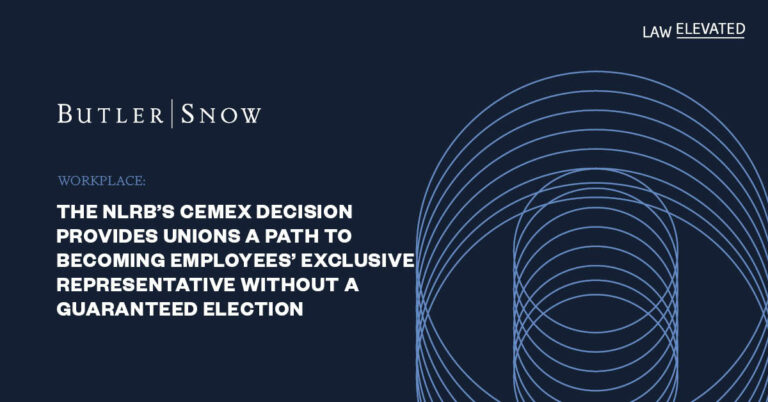On August 25, 2023, the National Labor Relations Board (“NLRB”) reversed decades of established law with the release of its decision in Cemex Construction Materials Pacific LLC (“Cemex”), NLRB Case No. 28-CA-230115. Cemex fundamentally changes the process for unions seeking representation: instead of running a new election when the NLRB finds evidence of employers committing unfair labor practices during the “critical period” (the period defined as when the union has signed authorization cards from a majority of the bargaining unit), the NLRB has lowered the evidentiary threshold for when it will forge ahead without re-running an election and issue a bargaining order.
Cemex’s Background
Cemex involved allegations that an employer committed unfair labor practices before, during, and after the “critical period” of an election campaign when the union had signed authorization cards from a majority of the bargaining unit. The Board described the alleged unfair labor practices committed by the employer that deemed the remedy of a Gissel bargaining order necessary, including: threatening multiple drivers with discipline (including termination) for displaying union support, including placing stickers on their hard hats; ordering employees to not talk to union organizers or union-friendly employees on “company time”; and terminating the employment of a key union supporter.
Gissel bargaining orders were once an “extraordinary remedy” reserved for cases where an employer committed flagrant violations that made a free and fair union election impossible. However, the Board found that the snowball effect of the unfair labor practices in Cemex had effectively prevented a full and fair election, resulting in the Gissel bargaining order instead of an election re-run.
Notably, the Board found that the employer’s continued unfair labor practices after the election also contributed to the Board’s decision to issue a Gissel order, holding that “the Respondent would likely meet a renewed organizing effort with further unfair labor practices tending to make a fair re-run election unlikely.”
The NLRB Turns Back Time Nearly Reviving the Joy Silk Era
The NLRB held in its 1949 Joy Silk decision that employers were required to recognize and bargain with the union where the union showed it had a majority of signed authorization cards, unless the employer had a “good faith doubt” regarding the cards’ authenticity and the accuracy of the alleged union support. However, this doctrine was deemed abandoned by the NLRB in the 1971 Linden Lumber case, which held that employers were allowed to refuse to accept evidence of a majority support of a union.
Under the new Cemex standard, if a union presents an employer with a demand for recognition and authorization cards signed by a majority of employees, an employer must either: (1) recognize the union as the bargaining representative; or (2) if the union has not already filed an election petition, promptly file an RM petition for an election to determine the union’s majority status or the appropriateness of the proposed bargaining unit (with “promptly” being defined as within two weeks of the union’s demand for recognition). However, in a shift from the Joy Silk doctrine, the employer can file the RM petition without a “good faith” doubt regarding the cards’ authenticity.
Cemex holds that if the employer commits any violation of the National Labor Relations Act throughout the election’s “critical period,” the Board may dismiss the RM petition (effectively nullifying the election results) and issue a bargaining order, which would require the employer to begin bargaining with the union. The NLRB also recognized additional grounds on which they could issue a bargaining order, such as if the employer refuses to recognize and bargain with the union upon being presented cards or if the employer does not timely file an RM petition.
The Board will continue to rely on the same factors that it uses to determine whether an election should be set aside due to an employer’s unfair labor practices, including but not limited to: the number and severity of unfair labor practices and the proximity of said practice(s) to the timing of the election; the size of the bargaining unit and margin of the vote; and the number of employees the misconduct reached.
Moving Forward: Employer Takeaways
One of the primary takeaways from the Cemex decision that employers should keep in mind is that the Board expressed a willingness to apply this decision retroactively. The uncertainty behind the applicability of the Cemex decision – a major focus of the dissenting opinion – is also something to keep in mind, as this decision arguably conflicts with Supreme Court precedent. Although the company has already proceeded to the D.C. Circuit Court of Appeals with a petition for review of this decision, employers would be wise to consider this decision as currently and legally binding.
Nevertheless, there are practical steps that employers can take now to reduce any potential liability. Employers should be trained in and prepared for union elections, especially with the new Cemex requirement that employers only have two weeks from when a union seeks recognition to file an RM petition. Employers should consider adding training sessions on appropriate actions to take during potential and actual union organizing. Given Cemex’s willingness to consider the employer’s post-election actions as an unfair labor practice, employers should be careful in how they operate through all stages of a potential union campaign – before, during, and after. Employers should also continue to review their handbooks and other policies to ensure compliance and change any rules that may lead to potential unfair labor practice allegations.
Employers who have any questions should contact Butler Snow’s Labor & Employment group for assistance.
